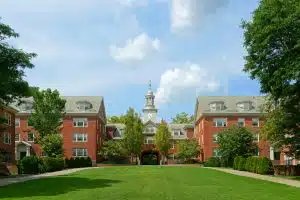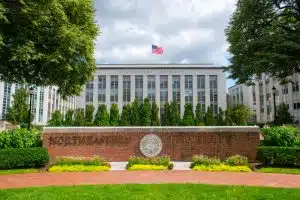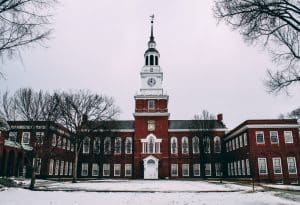Located in Rhode Island, Brown is a distinguished institution for its academic freedom, innovative research, and community engagement. This blog aims to provide a comprehensive look into Brown University, from its origins to the vibrant campus life today. Read on to learn more!
Brown University, located in Providence, Rhode Island, significantly influences its campus life and educational opportunities. It offers a mix of rich history and modern space. Providence, one of the oldest cities in the U.S., integrates old architecture with contemporary designs, providing a unique backdrop to your academic pursuits.
The city’s cultural scene enhances the Brown experience. With the Rhode Island School of Design (RISD) Museum and the WaterFire art installation, along with theaters, galleries, and music venues, you have plenty of opportunities to engage with the arts, complementing your studies.
Brown’s urban setting offers advantages over more isolated Ivy League schools. Being part of Providence’s fabric, you’re close to internships, job opportunities, and community projects, making your education relevant to real-world challenges. The city’s compact size encourages exploration and community engagement.
Brown’s location is central to its educational philosophy. The historical and cultural context of Providence, combined with its urban environment, offers an ideal backdrop for growth and future challenges.
Is Brown private or public?
Brown University is a private institution within the Ivy League, known for promoting independent thought and student-focused learning. Here, we’ll discuss Brown’s private status and its implications for prospective students and educational enthusiasts.
Understanding Brown’s Open Curriculum
Brown’s open curriculum provides unparalleled flexibility, allowing you to tailor your educational journey. This approach promotes interdisciplinary learning and empowers you to dive deep into your interests. The success of Brown’s alumni showcases how this freedom can open doors to inventive and fulfilling careers.
Admissions at Brown
Admission to Brown is competitive, focusing on academic performance, extracurricular involvement, and potential campus contribution. To stand out, showcasing unique experiences, talents, and aspirations is essential.
Experiencing Student Life at Brown
Student life at Brown features a vibrant community with clubs, organizations, and volunteer opportunities. Campus life is inclusive, offering connections that last a lifetime. This section highlights the experiences that shape student life.
Exploring Research Opportunities
Brown provides undergraduate research opportunities, offering access to facilities and faculty collaborations. Opportunities are available across disciplines, emphasizing Brown’s value of inquiry and discovery.
Preparing for Your Future
Brown’s career services and alumni network support professional development. Services include career advising and internship placements. The alumni network offers insights and connections in various fields, preparing students for success after graduation.
A Brief History of Brown
Founded in 1764, Brown University, the seventh-oldest college in the U.S., originally located in Warren, Rhode Island, relocated to Providence to accommodate its growing community. Brown was the first U.S. college to accept students regardless of religious background. This principle of inclusivity has shaped its educational approach, especially its open curriculum and student-led learning.
Early Days and Expansion
James Manning and Ezra Stiles established the college to offer high academic standards and strong moral values. Welcoming students of all faiths was a groundbreaking move. After relocating to Providence in 1770, Brown grew its campus and academic programs, laying the foundation for a broad-based university.
Innovative Education Model
In 1969, Brown launched its open curriculum, allowing students to customize their education. Unlike other colleges with fixed requirements, Brown encourages exploring various disciplines before choosing a major. This curriculum reflects Brown’s belief in academic freedom and prepares students for future challenges by fostering critical thinking and creativity.
Inclusivity and Impact
Brown has always aimed to be inclusive and socially responsible. It has initiatives for diversity on campus and supports all students through financial aid, making education accessible regardless of economic background. The university engages in research and projects addressing global issues like climate change and public health, showing its commitment to societal betterment.
Moving Forward
Today, Brown attracts students interested in a challenging and aware academic setting. Its liberal arts education and open curriculum draw those eager to shape their learning experiences. Brown’s history and contributions reflect its ongoing mission to educate future leaders ready to make positive changes in the world.
How big is the Brown campus?
Brown University covers 146 acres in Providence, Rhode Island’s College Hill neighborhood. It blends historic charm with modern architecture, offering a vibrant student life with its mix of buildings, green spaces, and study spots.
Discover Architectural Wonders
Walking through Brown’s campus, you see 18th-century buildings next to modern facilities. University Hall from 1770 and the Granoff Center for the Creative Arts show Brown’s history and modern edge. This variety supports learning and research in many fields.
Enjoy Green Spaces
Brown has many green areas, like the Main Green and Ruth J. Simmons Quadrangle, where you can relax, study, or meet friends. These places help build community and make the campus feel like home.
Live in a Supportive Community
Brown’s housing ranges from dorms to themed houses, helping you find your place and build connections. Dining, fitness, and cultural centers add to the sense of community.
What are the available facilities inside Brown?
Located in Providence, Rhode Island, Brown University’s campus has facilities designed to support and enhance its students’ and faculty’s academic, athletic, and extracurricular pursuits. Here are some of them:
- Parking Lots: Available for graduate students with an application process managed by the Brown Transportation Office.
- safeRIDE Services: Evening shuttle and on-call ride programs aimed at ensuring student safety.
- Access Shuttle: Weekday transportation service for students with disabilities, highlighting Brown’s commitment to accessibility.
- Brown Daytime Shuttle: Connects key locations such as Brown’s main campus, affiliated hospitals, and the Jewelry District on weekdays.
- Nelson Fitness Center: A modern facility with exercise machines, a varsity strength and conditioning center, exercise studios, and locker rooms.
- Katherine Moran Coleman Aquatics Center: Offers resources for swimming, diving, and water polo, catering to various aquatic activities.
- Olney-Margolies Athletic Center (OMAC): Features basketball, badminton, and volleyball courts, a 200-meter track, and fitness spaces.
- Pizzitola Sports Center: Home to courts for basketball, volleyball, wrestling, gymnastics, tennis, and squash.
- Stephen Robert ’62 Campus Center: Acts as a central hub for student activities, providing meeting spaces, dining options, and various student services.
- Center for Alcohol and Addiction Studies: Dedicated to research and education on alcohol and addiction.
- Center for Children’s Environmental Health: Focuses on studying the impact of environmental factors on children’s health.
- Center for Epidemiologic Research: Researches the distribution and determinants of health and diseases.
- Center for Evidence Synthesis in Health: Specializes in synthesizing evidence to improve health decision-making.
- Center for Geometric Computing: A hub for research in geometric computing.
- Center for Computational Molecular Biology (CCMB): Focuses on advancements in molecular biology through computational methods.
- Center for Fluid Mechanics, Turbulence, and Computation: Specializes in fluid mechanics research.
- Graphics and Visualization Center: Dedicated to research in computer graphics and visualization.
- Center for Human Rights & Humanitarian Studies: Engages in research and education on human rights and humanitarian issues.
- Center for Statistical Sciences: Focuses on research and education in statistical sciences.
- Center for the Study of Race and Ethnicity in America (CSREA): Dedicated to studying race and ethnicity.
- Ruth J. Simmons Center for the Study of Slavery and Justice: Focuses on the historical and contemporary issues of slavery and justice.
- Center for Language Studies: Provides resources and support for language studies.
- Center for Latin American and Caribbean Studies (CLACS): This program studies Latin America and the Caribbean.
- Center for Middle East Studies: Dedicated to studying the Middle East.
- Rockefeller Library: The main library of Brown University, housing a vast collection of books and resources.
- John Hay Library: Known for its special collections and archives.
- John Carter Brown Library: Specializes in the history of the Americas before the 20th century.
- Annmary Brown Memorial: Houses a collection of European and American paintings and memorabilia of the Brown family.
These facilities collectively support student life at Brown University, from academic research and athletic training to extracurricular activities and community engagement, embodying the institution’s commitment to providing a holistic educational experience.
What is Brown known for?
Choosing the right university is about finding a community that aligns with your academic goals, personal values, and aspirations. Brown University, a distinguished member of the Ivy League, is known for its unique approach to education. Here, we’ll highlight facets of Brown that make it a top choice for students who wish to become change-makers.
Discover Brown University
Located in Providence, Rhode Island, Brown University offers a distinct educational experience through its Open Curriculum, which grants unprecedented freedom to shape your educational journey. Unlike traditional paths at other institutions, Brown encourages exploration across disciplines.
Brown’s Academic Approach
The principles of Brown University are built around the belief that education should be learner-driven. The Open Curriculum allows you to tailor your academic pursuits to your interests and career aspirations, preparing you for today’s complex challenges.
Spotlight on Programs
The Computer Science program at Brown is known for its balance of theoretical knowledge and practical application. Faculty members like Maurice Peter Herlihy and Thomas L. Dean enrich the program with their research and expertise, offering opportunities to engage with the latest computer science.
The Economics program at Brown integrates theory and practice, supported by The Orlando Bravo Center for Economic Research. This approach equips you with the knowledge to solve real economic challenges, making it an exciting environment for aspiring economists. The Biology program offers comprehensive research opportunities and an interdisciplinary approach. Whether you’re interested in molecular biology or ecology, Brown provides a platform for exploration and contribution to the scientific community.
Research Making a Difference
Brown’s research initiatives address global challenges such as climate change and space debris. The university’s Arctic research and the SBUDNIC satellite project showcase Brown’s role in scientific research and environmental stewardship.
Making Education Accessible
Brown’s financial aid policy, which meets 100% of the demonstrated need for all students without loans, ensures that financial barriers do not hinder your educational aspirations. This policy reinforces Brown’s dedication to fostering an inclusive academic community.
Alumni Impact
Brown’s alumni network includes leaders across various fields, from education reformer Horace Mann to actress Emma Watson. Brown graduates are known for contributing to society, driven by comprehensive scholarship and a commitment to betterment.
Life at Brown
Experience at Brown goes beyond academics, enriched by traditions such as the Van Wickle Gates and Campus Dance. These student organizations and activities cultivate a sense of community.
What is outside the Brown campus?
Exploring outside Brown University’s campus, located in Providence, Rhode Island, reveals engaging activities and sights. Here’s what you can discover:
- East Side Pockets: A student favorite located along Thayer Street, known for having the best falafel around.
- Insomnia Cookies: Famous for its late-night cookie deliveries, this spot is a hit on Thayer Street, housed in one of the street’s oldest buildings.
- Haffenreffer Museum of Anthropology: Located at 21 Prospect St., this museum offers insights into various cultures through its anthropological collections.
- Lippitt House Museum: At 199 Hope St., this museum showcases the city’s rich history and architecture.
- Cohen Gallery (Granoff Center): Found at 154 Angell St., the gallery exhibits contemporary art in a modern space.
- Bell Gallery (List Art Building): Located at 64 College St., this gallery features artworks from various periods and styles.
- Rhode Island School of Design Museum: At 20 N. Main St., this museum is renowned for its extensive collection of art and design pieces.
- Brown Bookstore: A go-to on Thayer Street for Brown University gear and reading materials.
- Wayland Square: A historic neighborhood on Providence’s East Side, offering independent retail shops, cafes, and restaurants.
- The Arcade Providence: America’s oldest indoor shopping mall at 65 Weybosset St., known for its historical architecture, dining, and unique retail shops.
- Providence River Pedestrian Bridge: Connects the East Side to the Jewelry District, featuring park space and city skyline views.
- India Point Park: Offers sweeping views of Providence Harbor and Seekonk River along with bike and walking paths.
- Prospect Terrace Park: Known as “The Jewel of the City,” this park on Congdon Street offers an elevated view of downtown Providence.
- Benefits Street: Celebrated for its vibrant collection of 18th- and 19th-century architecture, including restored houses, churches, and museums.
Brown Dorms and Other Housing Options
Let’s explore the residences available during your time at Brown. Each offers unique features, ensuring a comfortable and memorable college experience.
- Archibald-Bronson: Part of Keeney Quadrangle, renovated in 2013 with elevators, accessible bathrooms, lounges, and upgraded amenities.
- Everett-Poland: Located in Brown’s Keeney Quadrangle, named for Professor Walter G. Everett, renovated in 2013 with modern amenities.
- Jameson-Mead: Honors Professor John F. Jameson, who was part of the 2013 renovations in Keeney Quadrangle, adding modern facilities.
- Andrews Hall: Built in 1947, named after Elisha Benjamin Andrews, it underwent significant renovations, including the addition of Andrews Commons.
- Metcalf Hall: Constructed in 1919 on the Pembroke College campus, renovated in 2013 to include upgrades and create first-year housing.
- Miller Hall: A Colonial-style building from 1910, renovated in 2013 alongside Metcalf and Andrews Halls for First Year housing.
- Morriss Hall: Built in 1960, named for Margaret S. Morriss, renovated in 2001 as part of the Pembroke College residence and dining quadrangle.
- Champlin Hall: Also built in 1960 and renovated in 2001, named for George B. Champlin, part of the first Pembroke College quadrangle.
- Emery Hall: Constructed in 1963 and renovated in 2002, named after Anne Crosby Emery Allinson, part of Pembroke Quadrangle.
- Woolley Hall: Added to the Pembroke Quadrangle in 1963, it serves as a student dormitory.
- New Pembroke 1-4: A four-building residential complex designed by Donlyn Lyndon, blending into the surrounding area with an award-winning design.
- 111 Brown Street: Brown’s smallest residence hall, accommodating only 13 students.
- 219 Bowen St: One of the smallest residence halls on campus, housing 16 students.
- 315 Thayer: A historical building renovated in 2012 with modern amenities and a LEED Gold rating.
- Barbour Hall & Apartments: Named after Clarence Barbour, part of Bryant College, offers residence and apartment-style living.
- Buxton House: Home to Buxton International House, named for Colonel G. Edward Buxton, Jr.
- Chapin House: Part of the Wriston Quadrangle, named for Dr. Charles V. Chapin, received cosmetic upgrades in 2014.
- Diman House: Also in the Wriston Quadrangle, named for Jeremiah Lewis Diman, underwent cosmetic upgrades in 2014.
- Goddard House: Named after William Giles Goddard, it received cosmetic upgrades in 2014 as part of Wriston Quadrangle enhancements.
- Harkness House: Named for Professor Albert Harkness, it serves as a residence hall within the Wriston Quadrangle.
- King House: Acquired from Bryant College in 1969, named after Lida Shaw King, serves as a residence hall and home to St. Anthony Hall.
- Machado House: Originally Ellen Dexter Sharp House, it is now home to several of Brown’s program houses.
- Marcy House: Named after William L. Marcy, it received cosmetic upgrades in 2014 and is part of the Wriston Quadrangle.
- Olney House: Named in honor of Richard Olney, it underwent cosmetic upgrades in 2014 and hosts Sigma Chi and Delta Tau Fraternity.
- Sears House: Part of Wriston Quadrangle, named for Barnas Sears, President of the University from 1855 to 1867.
- West House: Houses Environmental House, one of Brown’s program houses, is located on the corner of Brown and Meeting Streets.
What is Brown’s impact on Rhode Island?
Brown University significantly affects Providence and Rhode Island’s economy and healthcare. Its financial investments, educational contributions, and medical research are key to local and regional development.
Economic Contributions and Local Development
Brown University is a major employer in Providence, providing $7.4 million in scholarships to Rhode Island high school graduates in 2022, $477 million in payroll, and $218 million in goods and services from local vendors.
It also invested $341 million in Providence’s Jewelry District and $619 million in construction projects in Rhode Island from 2018 to 2022. Visitor spending adds $13.3 million annually to the local economy, supporting over a thousand businesses and stimulating economic growth.
Impact on Healthcare and Medical Education
The university impacts healthcare by improving outcomes for Rhode Island residents. It houses the state’s only schools of medicine and public health, leading in care, research, and education. The Warren Alpert Medical School improves the healthcare workforce by educating physicians. Brown’s research addresses health challenges like the opioid crisis, food insecurity, and reproductive health.
Strengthening Partnerships for Future Advancements
Brown plans to collaborate with Rhode Island’s largest health systems, Care New England and Lifespan, to create an integrated academic health system by 2024. This aims to enhance clinical care and health research, reinforcing Brown’s role in the state’s health and economic development.
Through these efforts, Brown University shows how educational institutions can drive economic development and healthcare improvements, benefiting the community and society.
Famous Landmarks Inside the Brown Campus
Brown University, located in Providence, Rhode Island, features landmarks that enrich its academic and social scene. These landmarks are popular for student activities and carry historical and architectural significance, enhancing your experience at Brown.
1. Main Green
The Main Green is the central hub for student activities, surrounded by buildings for classes, administrative offices, and dorms. It hosts events like concerts and political rallies, and it’s common to see outdoor classes here on sunny days.
2. Quiet Green
Next to the Main Green, the Quiet Green offers a quieter space for reading or peaceful conversations. Close to University Hall and Manning Chapel, it’s known for its calm atmosphere. The Van Wickle Gates, opening only for new students and graduating seniors, marks a tradition that fosters community spirit.
3. Faunce House
Faunce House, the Stephen Roberts ’62 Campus Center, is a key spot for student gatherings, study, and coffee breaks at the Blue Room Cafe. It also hosts various administrative services, highlighting Brown’s focus on student life.
4. Pembroke Campus
Once a separate women’s college, the Pembroke Campus now integrates with the main campus, providing amenities and housing for first-year students. It has played a role in Brown’s history of coeducation since 1971.
5. Sciences Library
The Sciences Library, or SciLi, offers study spaces, science resources, and a meditation room. Its upper floors provide views of the campus and College Hill, making it a preferred study location.
Conclusion
Brown University is a vibrant community located in the heart of Providence, Rhode Island, fostering a unique blend of academic freedom, innovative research, and a deeply engaged student body. Whether you’re strolling through the historic campus, participating in cutting-edge research, or engaging with the local community, Brown offers a rich, multidimensional college experience that prepares students to make meaningful contributions to the world.










































